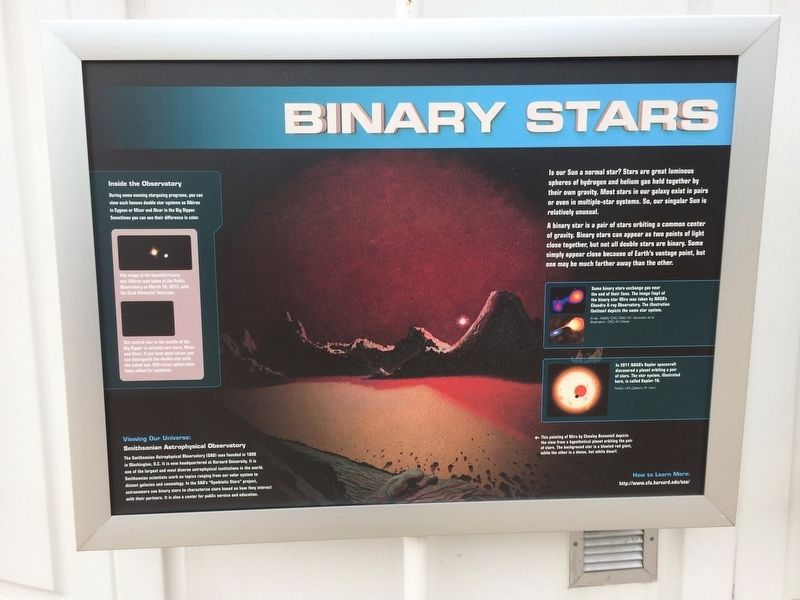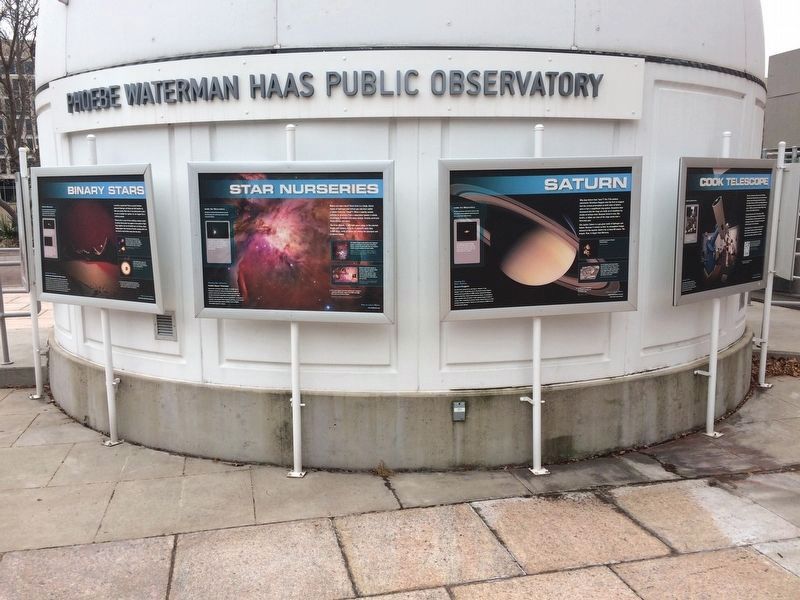The National Mall in Southwest Washington in Washington, District of Columbia — The American Northeast (Mid-Atlantic)
Binary Stars
Is our Sun a normal star? Stars are great luminous spheres of hydrogen and helium gas held together by their own gravity. Most stars in our galaxy exist in pairs or even in multiple-star systems. So, our singular Sun is relatively unusual.
A binary star is a pair of stars orbiting a common center of gravity. Binary stars can appear as two points of light close together, but not all double stars are binary. Some simply appear close because of Earth's vantage point, but one may be much farther away than the other.
Captions:
Inside the Observatory
During some evening stargazing programs, you can view such famous double star systems as Albireo in Cynus or Mizar and Alcar in the Big Dipper. Sometimes you can see their difference in color.
This image of the beautiful binary star Albireo was taken at the Public Observatory on March 18, 2015, with the Cook Memorial Telescope.
The central star in the handle of the Big Dipper is actually two stars, Mizar and Alcor. If you have good vision, you can distinguish the double star with the naked eye. Diffraction spikes have been added for emphasis.
Viewing Our Universe:
Smithsonian Astrophysical Observatory
The Smithsonian Astrophysical Observatory (SAO) was founded in 1890 in Washington, D.C. It is now headquartered at Harvard University. It is one of the largest and most diverse astrophysical institutions in the world. Smithsonian scientists work on topics ranging from our solar system to distant galaxies and cosmology. In the SAO's "Symbiotic Stars" project, astronomers use binary stars to characterize stars based on how they interact with their partners. It is also a center for public service and education.
Some binary stars exchange gas near the end of their lives. The image (top) of the binary star Mira was taken by NASA's Chandra X-ray Observatory. The illustration (bottom) depicts the same star system.
X-ray: NASA/CXC/SAO/M. Karovska et al.
Illustration: CXC/M. Weiss
In 2011 NASA's Kepler spacecraft discovered a planet orbiting a pair of stars. The star system, illustrated here, is called Kepler-16.
NASA/JPL-Caltech/R. Hurt
←This painting of Mira by Chesley Bonestell depicts the view from a hypothetical planet orbiting the pair of stars. The background star is a bloated red giant, while the other is a dense, hot white dwarf.
How to Learn More:
http://www.cfa.harvard.edu/sao/
Erected by National Air and Space Museum.
Topics. This historical marker is listed in this topic list: Air & Space. A significant historical year for this entry is 1890.
Location.
Other nearby markers. At least 8 other markers are within walking distance of this marker. Saturn (here, next to this marker); Moon (here, next to this marker); Phoebe Waterman Haas (here, next to this marker); Jupiter (here, next to this marker); Venus (here, next to this marker); Star Nurseries (here, next to this marker); Cook Telescope (here, next to this marker); Sun (here, next to this marker). Touch for a list and map of all markers in Southwest Washington.
Credits. This page was last revised on January 30, 2023. It was originally submitted on December 12, 2017, by Devry Becker Jones of Washington, District of Columbia. This page has been viewed 214 times since then and 13 times this year. Photos: 1, 2. submitted on December 12, 2017, by Devry Becker Jones of Washington, District of Columbia. • Bill Pfingsten was the editor who published this page.

